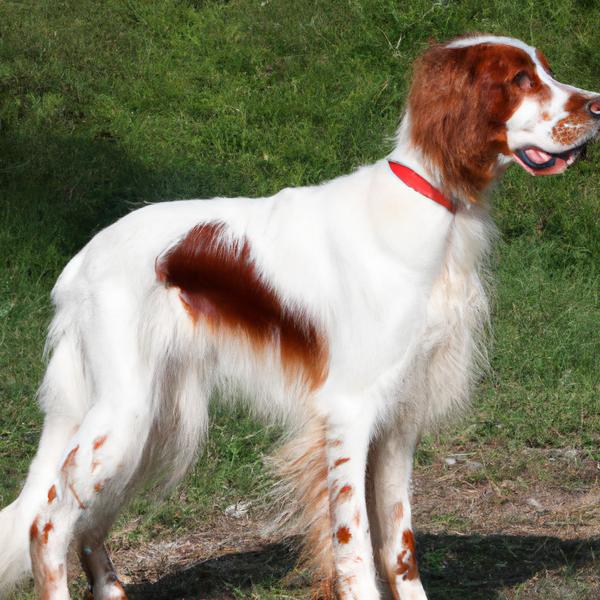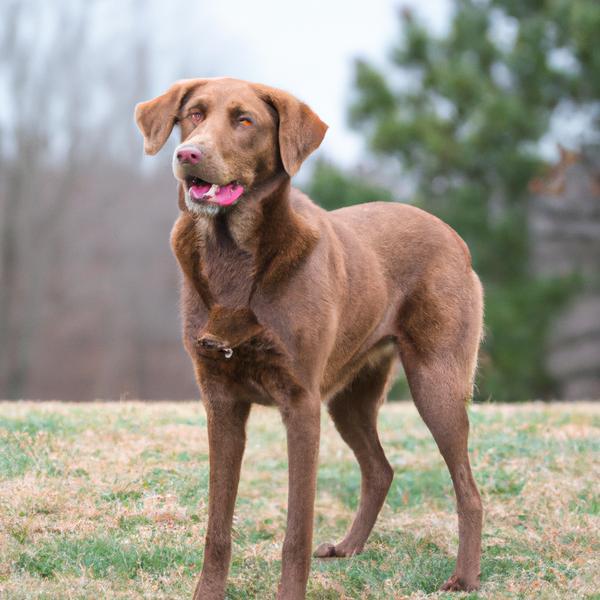Chesapeake Bay Retriever vs. Standard Ratzer: Breed Differences and Similarities
Hypoallergenic
Are Chesapeake Bay Retrievers or Standard Ratzers hypoallergenic, or neither?
Unfortunately, the Chesapeake Bay Retriever is not hypoallergenic, making it not a good choice for a dog lover who suffers from pet allergies.
While no dogs are truly 100% hypoallergenic, Standard Ratzers are about as close as it gets, making them an ideal pet if you are an allergy sufferer.
Temperament
What are the personalities of Chesapeake Bay Retriever and Standard Ratzer dogs?
Happy
Dominant
Protective
Affectionate
Intelligent
Quiet
Playful
Loving
Alert
Intelligent
Affectionate
Devoted
Lively
Inquisitive
Trainable
Good-natured
Shedding Level
Do Chesapeake Bay Retrievers shed more than Standard Ratzers, or which breed sheds more, Chesapeake Bay Retrievers or Standard Ratzers?
Chesapeake Bay Retriever or Standard Ratzer dogs are not heavy shedders, but they will lose a significant amount of hair each year. To decrease the amount of shedding, you can regularly brush your Chesapeake Bay Retriever or Standard Ratzer. This will remove loose hair and keep their coat growing in the same direction.
Origin
What is the origin of Chesapeake Bay Retriever and Standard Ratzer dog breeds?
United States
United States
Ancestry
What are the origins of Chesapeake Bay Retriever and Standard Ratzer breeds?
Newfoundland dog
Rat Terrier, Standard Schnauzer
Date of Birth
When were Chesapeake Bay Retriever and Standard Ratzer breeds first developed?
1800s
Unknown
Eye Color Possibilites
What are the eye colors of Chesapeake Bay Retriever and Standard Ratzer dogs?
Brown
Amber
Blue
Hazel
Brown
Amber
Nose Color Possibilites
What are the natural nose colors of Chesapeake Bay Retriever and Standard Ratzer?
Brown
Black
Brown
Coat Color Possibilites
What are the natural colors of the coat for Chesapeake Bay Retriever and Standard Ratzer breeds?
Brown
Red
Black
Gray
Brown
Red
Cream
Fawn
Silver
White
Pied
Sable
Brindle
Coat Length
What is the typical coat length for Chesapeake Bay Retriever and Standard Ratzer breeds?
Chesapeake Bay Retrievers have coats that can be either short or medium in length.
Standard Ratzers have medium-length coats.
Coat Density
What is the density of the coat of Chesapeake Bay Retriever and Standard Ratzer?
Coat Texture
What is the hair texture of Chesapeake Bay Retriever and Standard Ratzer?
Wavy
Wiry
Litter Size
What is the usual litter size for Chesapeake Bay Retriever and Standard Ratzer?
A Chesapeake Bay Retriever can have a litter of 10-13 puppies on average. However, it's worth noting that the size of the litters can vary greatly. Factors that can influence litter size include the health of the mother, breeding history, and genetics.
A Standard Ratzer can have a litter of 4-8 puppies on average. However, it's worth noting that the size of the litters can vary greatly. Factors that can influence litter size include the health of the mother, breeding history, and genetics.
Adaptability
Chesapeake Bay Retrievers have average adaptability to changes in lifestyle and living environments compared to other breeds.
Standard Ratzers are known for their adaptability and can adjust well to different environments and lifestyle changes.
Health Issues
Between Chesapeake Bay Retriever and Standard Ratzer, which breed is more prone to health problems?
While the Chesapeake Bay Retriever breed is generally healthy, occasional vet check-ups are still necessary to address any health concerns.
Standard Ratzers are susceptible to health issues like all breeds, so it's important to monitor their health and seek veterinary care when needed.
Major Concerns
What are the major health concerns for Chesapeake Bay Retriever and Standard Ratzer breeds?
Hip Dysplasia
Patellar Luxation
Pulmonic Stenosis
Hip And Elbow Dysplasia
Portosystemic Shunt
Minor Concerns
What minor health issues should be kept in mind when owning Chesapeake Bay Retriever and Standard Ratzer?
Progressive Retinal Atrophy
Cataracts
Demodectic Mange
Schnauzer Comedo Syndrome
Skin Diseases and Disorders
Eye Conditions (Cataracts, Lens Luxation)
Occasional Tests
What occasional tests are recommended for Chesapeake Bay Retriever and Standard Ratzer breeds?
Eye
Hip
Blood
Dna For Vwd
Physical Examination
Eye Examination
Skin Evaluation
Blood And Urine Analysis
Diagnostic Imaging
DNA
Social Needs
Chesapeake Bay Retriever vs Standard Ratzer social needs comparison
Chesapeake Bay Retriever has average social needs and is less independent than other breeds.
Standard Ratzer has very high social needs and requires regular mental and physical stimulation, a job or purpose, and companionship.
Sleeping Need
Which of the two sleeps the most/least: Chesapeake Bay Retriever or Standard Ratzer?
Chesapeake Bay Retriever and Standard Ratzer are active dogs that may not require as much sleep as other breeds. However, they still need enough sleep to stay healthy.
Mouthiness
Mouthiness Comparison: Chesapeake Bay Retriever vs Standard Ratzer?
Roaming urge
Chesapeake Bay Retriever vs Labrador: Running away tendency?
Prey Drive
Chesapeake Bay Retriever or Standard Ratzer - which breed has a higher level of prey drive?
Activity Level
Which breed has higher energy, Chesapeake Bay Retrievers or Standard Ratzers?
Chesapeake Bay Retrievers are high-energy dogs. They need mental as well as physical exercise. These dogs require a lot of your involvement and without it they can, and will, become problematic dogs.
Standard Ratzers are medium-energy dogs and typically enjoy socializing and playing casual or even sustained games of chase with other dogs. They may also have occasional periods of barking or racing around the house.
Tolerance of being left alone
Walks per Week
How many miles should Chesapeake Bay Retriever or Standard Ratzer walk each week?
There's really no limit to how far you walk your dog as long as they're comfortable. For Chesapeake Bay Retriever, it's at least 14 miles / week. Just remember to build distance and stamina gradually over time.
There's really no limit to how far you walk your dog as long as they're comfortable. For Standard Ratzer, it's at least 6 miles / week. Just remember to build distance and stamina gradually over time.
Activity per Day
Do Chesapeake Bay Retrievers or Standard Ratzers require more exercise?
In general most Chesapeake Bay Retrievers usually need at least 90 minutes of exercise daily. This can be spread across the day and include all sorts of high-energy activities, like walking, running and playing.
In general most Standard Ratzers usually need at least 60 minutes of exercise daily. This can be spread across the day and include all sorts of high-energy activities, like walking, running and playing.
Grooming
Which breed is easier to maintain in terms of grooming, Chesapeake Bay Retrievers or Standard Ratzers?
The Chesapeake Bay Retriever has low grooming needs and is easy to maintain.
The Standard Ratzer requires an average amount of grooming compared to other breeds.
Brushing Frequency
What is the recommended brushing frequency for Chesapeake Bay Retriever and Standard Ratzer dogs?
Chesapeake Bay Retriever should be brushed at least once a week. Of course you can give them more frequent brushes if you find that they are still shedding a lot
Ideally, Standard Ratzer should be brushed at least 2 or 3 times a week (preferably daily) improve shedding.
Brushing Tools
What brushing tools are used for Chesapeake Bay Retrievers and Standard Ratzers?
Slicker Brush
Comb
Nail Clipper
Pin Brush
Dematter
Deshedder
Nail Clipper
Cups
How much food should be given to Chesapeake Bay Retriever or Standard Ratzer in cups?
For an average 65-80 pound (29 - 36 kg) Chesapeake Bay Retriever feed 2.8 cups daily. But, keep in mind, the amount you feed is going to be dependent on the quality of the food you are feeding.
For an average 20-30 pound (9 - 14 kg) Standard Ratzer feed 1.5 cups daily. But, keep in mind, the amount you feed is going to be dependent on the quality of the food you are feeding.
Daily Cost
Which breed has a higher daily cost, Chesapeake Bay Retriever or Standard Ratzer?
The average cost of a Chesapeake Bay Retriever is somewhere $2.10 - $2.70 per day.
The average cost of a Standard Ratzer is somewhere $1.70 - $2.20 per day.
Monthly Cost
Which breed has a higher monthly cost, Chesapeake Bay Retriever or Standard Ratzer?
The average per month expenses of a Chesapeake Bay Retriever is between $55 - $73. This makes an average of $660 - $876 per year. It will be on the higher side when the dog is still small because it will need more frequent visits to the vet, shots.
The average per month expenses of a Standard Ratzer is between $34 - $67. This makes an average of $408 - $804 per year. It will be on the higher side when the dog is still small because it will need more frequent visits to the vet, shots.
Sensitivity Level
How do Chesapeake Bay Retriever and Standard Ratzer compare in sensitivity?
Chesapeake Bay Retrievers have average emotions and adapt well to different situations.
This breed is sensitive and requires gentle handling and a calm home environment.
Apartment Friendly
Which breed is more apartment-friendly: Chesapeake Bay Retriever or Standard Ratzer?
The Chesapeake Bay Retriever is not suitable for apartments and requires a large yard to thrive. Pent-up energy in small spaces can lead to destructive behavior.
The Standard Ratzer is a great apartment dog, thriving with sufficient exercise and time outside as part of their daily routine.
Child Friendly
Do Chesapeake Bay Retrievers or Standard Ratzers have a friendlier temperament towards children?
Chesapeake Bay Retrievers are good with kids if socialized and trained from a young age.
Standard Ratzers make excellent family pets for kids due to their gentle, protective nature and calm temperament.
Senior-friendly
Which dog is more suitable as a pet for the elderly - Chesapeake Bay Retriever or Standard Ratzer?
Cat Friendly
Do Chesapeake Bay Retriever or Standard Ratzer breeds have a better compatibility with cats?
Chesapeake Bay Retrievers are average in their friendliness toward cats and tend to do well with them, especially if raised together.
Standard Ratzers are good with cats, but early training is needed to prevent chasing behavior.
Dog Friendly
Which breed is more sociable with other dogs: Chesapeake Bay Retriever or Standard Ratzer?
Chesapeake Bay Retrievers are less friendly towards other dogs, but can improve with socialization.
Standard Ratzers are friendly and active companions, and can be good family pets, though their friendliness towards other dogs may vary.
Pet friendly
How do Chesapeake Bay Retriever or Standard Ratzer dogs interact with other pets?
Stranger Friendly
Which breed is more friendly with strangers: Chesapeake Bay Retriever or Standard Ratzer?
Chesapeake Bay Retrievers are quick to announce strangers and can be standoffish or suspicious.
Standard Ratzers are friendly but may bark at strangers, and training is easy due to their intelligence.
Playfulness
Which breed is more playful between Chesapeake Bay Retriever and Standard Ratzer?
Chesapeake Bay Retriever and Standard Ratzer are playful dogs. So, no matter how busy the day may get, the best thing you can do for Chesapeake Bay Retriever and Standard Ratzer is to make time each day to play. It can be as little as 15-20 minutes, and it will mean the world to them.
Trainability
How do the trainability levels of Chesapeake Bay Retrievers and Standard Ratzers compare?
Chesapeake Bay Retrievers are usually easy to train but require consistency to fully obey commands.
Standard Ratzers are popular for their ease of training and quick learning ability.
Compare Chesapeake Bay Retriever with other breeds

Greyhound
Chesapeake Bay Retriever vs Greyhound

Xoloitzcuintle
Chesapeake Bay Retriever vs Xoloitzcuintle

Irish Mastiff
Chesapeake Bay Retriever vs Irish Mastiff

Maremma Sheepdog
Chesapeake Bay Retriever vs Maremma Sheepdog

Sheltidoodle
Chesapeake Bay Retriever vs Sheltidoodle

Irish Red and White Setter
Chesapeake Bay Retriever vs Irish Red and White Setter

Chin Crested
Chesapeake Bay Retriever vs Chin Crested

Dusky
Chesapeake Bay Retriever vs Dusky

Wirehaired Vizsla
Chesapeake Bay Retriever vs Wirehaired Vizsla

Siberian Husky
Chesapeake Bay Retriever vs Siberian Husky

Rott Pei
Chesapeake Bay Retriever vs Rott Pei

Shelestie
Chesapeake Bay Retriever vs Shelestie

